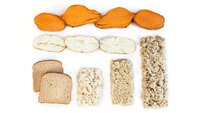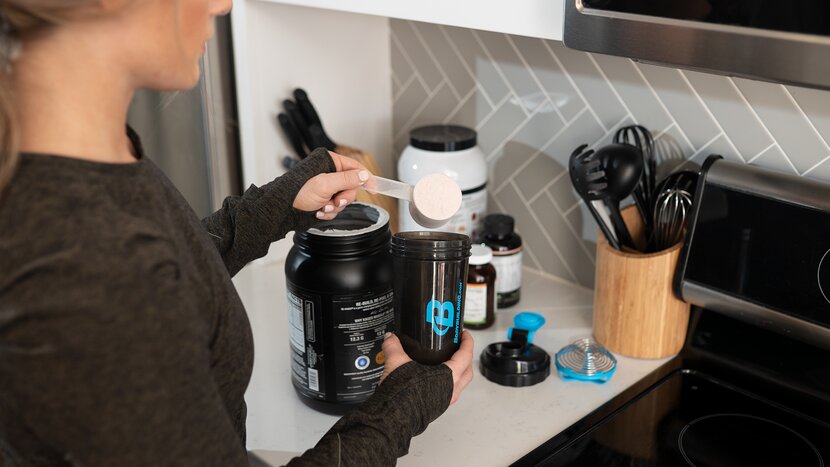The amount of protein you need depends on a number of factors, including your weight, age, goals, and activity level. The daily minimum recommended by the National Institutes of Health is 0.36 grams per pound of body weight for a sedentary person. However, if you do intense workouts, have a physically demanding job, or both, experts say you may need more—perhaps as much as double.
This calculator will tell you how much protein to eat each day based on your specific body and lifestyle. Dial in this nutritional priority to take control of your nutrition and nail your goals!
Protein Intake Calculator
This daily protein target can help you lose weight in the form of body fat while minimizing muscle loss. Here are the next steps on your weight loss journey:
1. Pick a weight-loss workout plan.
A well-designed program is an essential part of turning hard numbers into hard-body results! Here are the most popular ones from BodyFit:
2. Calculate your macronutrient ratio.
Protein is just one of the three macronutrients. To get targets for the other two, as well as a daily calorie target, use the Bodybuilding.com Macronutrient Calculator.
3. Learn about the best fat-loss supplements.
Supplements can help you accelerate your results once you have your protein intake and training in place. Krissy Kendall, Ph.D., shares her recommendations in the article, "5 Ways to Up Your Fat-Loss Supplement Game."
4. Join a fitness community.
For over 10 years, members of BodySpace have been helping each other build their best bodies. Join a fitness community that's over 2 million people strong!
This daily protein target can help you build lean muscle mass while minimizing body-fat gains. Here are the next steps on your journey to see the scale go up:
1. Pick a muscle-building workout plan.
A well-designed program is an essential part of turning hard numbers like calories into hard-body results! Here are the most popular ones from BodyFit:
2. Calculate your macros.
Protein is just one of the three macronutrients. To get targets for the other two, as well as a daily calorie target, use the Bodybuilding.com Macronutrient Calculator.
3. Learn about the best supplements for gaining muscle.
Supplements can help you accelerate your muscle-building results once you have your protein intake and training nailed. Krissy Kendall, Ph.D., shares her recommendations in the article, "8 Proven Supplements for Muscle Growth and Strength."
4. Join a fitness community.
For over 10 years, members of BodySpace have been helping each other build their best bodies. Join a fitness community that's over 2 million people strong!
This daily protein target can help you focus on body recomposition, or gradually burning fat and building muscle, while focusing on your health. Here are the next steps on your journey to customize your nutrition:
1. Pick a workout plan.
A well-designed program is an essential part of staying motivated and seeing results. Here are some of our most popular programs from BodyFit:
2. Calculate your macros.
Protein is just one of the three macronutrients. To get targets for the other two, as well as a daily calorie target, use the Bodybuilding.com Macronutrient Calculator.
3. Learn about the best health-focused supplements.
Supplements can help you accelerate your results and support your training once you have your protein target and training in place. Chris Lockwood, Ph.D., shares what to take and why in the article, "Start Here: The Most Important Supplements for Every Body."
4. Join a fitness community.
For over 10 years, members of BodySpace have been helping each other build their best bodies. Join a fitness community that's over 2 million people strong!
Which Goal and Activity Level Should I Choose?
Maintain Current Weight
First time tracking your protein? Or not sure which goal is right for you? Then start with "maintenance." Many nutritionists say before you start tweaking your macronutrients and protein intake, you should spend some time at maintenance level and get more comfortable with tracking your foods and portion sizes.
Choosing "maintain current weight" will give you a protein intake of around 1 gram per pound of body weight, a target many experts recommend for overall health and athletic performance.
Lose Weight
If you know that you're ready to lose a few pounds and you have some experience counting calories or tracking macros, select "lose weight." This will give you a slightly higher protein intake to aim for than weight maintenance. Why higher? Because when you're looking to lose weight, extra protein can help you control your appetite and minimize muscle loss.
Gain Weight
Many people take what sounds like a simple approach to gaining weight: Eat all the protein they can handle and train as often and as hard as possible. This may work for a few days or weeks, but it's often tough to stick with. Selecting "gain weight" will give you a strategic bump up in protein that reflects a moderate calorie surplus of 500 calories, on a 40/30/30 macro split. If this doesn't make the scale go up after a couple of weeks, you may need to add a few hundred more calories from carbs or fats—probably not more protein.
Activity Level
This choice should reflect the amount of activity in your life based on how you exercise and how physically active your life or job is. Nutritional researchers agree that both calorie and nutrient estimates should take more into account than just the amount you exercise. Here's how to figure out what's right for you:
- Sedentary: You work at a desk job and you don't do much housework, walking, or exercising.
- Lightly active: You don't exercise much, but you go for walks 1-3 times per week and are on your feet doing housework during some of the day.
- Moderately active: You exercise 3-5 times a week and stay moving throughout the day with non-exercise activities.
- Very active: You exercise intensely or play vigorous sports on most days.
- Extra active: You exercise intensely or play vigorous sports nearly every day, including occasional "two a days." You also work a physical job or are on your feet most of the time.
What Are the Best High-Protein Foods?
Once you have a daily protein target to aim for, the next puzzle is how to figure out what foods can help you get there each day.
What foods will work best for you depends on your dietary preferences, budget, and eating style, which is why we've collected a comprehensive list to serve every type of circumstance in the "Ultimate List of 40 High-Protein Foods." But one thing is true: Eating all of that protein in a single meal won't be much fun! You'll feel a whole lot better, and stick with your approach for longer, if you have a plan.
If you're struggling to get enough protein, consider these time-tested strategies:
- Eat 3-4 solid meals a day, each containing 20-40 grams of protein.
- If you're vegetarian, pair complementary proteins as often as possible to create complete proteins.
- Eat protein-rich snacks like nuts, jerky, or a smoothie or protein shake.
- Have a post-workout protein shake containing 20-40 grams of protein.
The Bodybuilding.com Recipe Database also contains hundreds of recipes to help you get more protein in your diet, ranging from hearty breakfasts to decadent desserts and every meal in between.
Daily protein targets are a lot easier to reach with a protein shake. Use it as a post-workout reward or as a healthy meal replacement anytime. - View All
How Do I Calculate the Protein in My Food?
You can do this using food labels, as well as by weighing out your food on a food scale and using one of the many online nutritional databases.
Weighing food may seem like a lot of counting and not much fun, but it gets easier over time. Fitness coach Vince Del Monte says in the article, "From Here to Macros: 4 Steps to Better Nutrition" that you quickly learn to "eyeball" quantities of both calories and macronutrients after just a few weeks of practice.
Bodybuilding.com has also created visual guides to help you learn the skills of eyeballing different macronutrients.
Get Systematic About Your Results
Once you have your daily protein intake, it's time to take the same kind of strategic approach to the rest of your training and nutrition. These popular calculators can help you dial in your plan!















